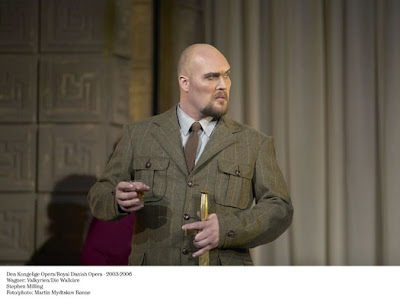KARITA MATTILA - CAREER
Karita Mattila, Finnish soprano. Born 1960, Somero, Finland.Education: Sibelius Academy, Helsinki. Further studies with Vera Rozsa.
Winner of the first Cardiff Singer of the World competition 1983.
Karita Mattila´s career initially centered around Mozart (Pamina, Countess, Donna Elvira) with debuts at Covent Garden (1985) and the Metropolitan Opera 1990 (Countess). A heavy performance schedule during these early years led to a vocal crisis requiring surgery on her vocal chords in 1992, one of the reasons she currently limits her annual performances to about 50. Karita Mattila´s career seemed to have reached a plateau in the early 90´s, however in the mid-90´s she re-emerged in the lyric-dramatic repertoire with highly acclaimed interpretations such as Chrysothemis (Salzburg 1995) and Elsa (Paris 1996), and she is now one of the absolutely leading sopranos of her generation with performances in all major opera houses, in particular the Metropolitan Opera.
Karita Mattila is reknowned for the beauty and versatility of her lyric-dramatic voice, with an exceptionally beautiful middle register as well as for her extraordinary stage ability and range of expressivity. Karita Mattila is also an admired recitalist and exponent of new music, particularly that of compatriot Kaija Saariaho, who also wrote a song cycle for her, Quatre Instants in 2002 as well as an opera Emilie du Chatelet in 2010.
Karita Mattila on the profession:
"It doesn't do any harm if you look good and take care of yourself. I lost 40 pounds through Weight Watchers when I was 22 and I am glad I did it. I wasn't fat, but I was plump, and I didn't feel comfortable. It has been an eternal battle. It has nothing to do with vanity; it's just to serve your work by looking the part.""I don't break my contracts for personal reasons because I owe it to my audience to be there. If it has already been announced that I will be singing there, then I think it would be very unprofessional for me to cancel."
"There is always room at the top, and it is very windy, meaning that it is harder to be at the top than on the way up."
KARITA MATTILA - KEY ROLES AND PERFORMANCES
Elsa (Lohengrin) - Paris Bastille Opera 1996 (d: Carsen), Metropolitan Opera 1998, 2006 (d: Robert Wilson). Her immensely beautiful middle register and secure top made Karita Mattila the ideal Elsa, a role she now seems to have retired from her repertoire. She was unsurpassed in this role, possibly her finest to date.Chrysothemis (Elektra) - according to Mattila, this role in Salzburg 1995 marked her transition from Mozart to the heavier lyric-dramatic repertoire, for which she is reknowned today. She seems to have retired this part as well.
Fidelio - Metropolitan Opera, London ROH (MET premiere 2001, d: Flimm) - also on DVD. One of Karita Mattila´s signature roles, which she continues to perform worldwide.
Katya Kabanova, Jenufa, Emilia Marty - Karita Mattila has a special affinity for Janacek´s heroines, which she continues to perform at major stages worldwide, as in the DVD released Katya Kabanova in Madrid 2008
Salome - Paris Bastille Opera 2003 and Metropolitan Opera 2004 and 2008 (also on DVD). Karita Mattila´s Salome is among the most admired operatic performances of the last decade. Sound clips from the 2004 Met performance and video clips from her Paris Salome here.
Review of Karita Mattila´s 2008 Met Salome, which was also transmitted live in HD and released on DVD.
Puccini heroines - Tosca (Met Opening Season 2009 released on DVD and Bavarian State Opera 2010), which she sang to mixed reviews and now seems to have retired. Manon Lescaut (among others Metropolitan Opera 2008, also released on DVD).
Previously, Karita Mattila had major successes in the Italian repertoire such as Elisabeth in Don Carlos (d: Bondy, Covent Garden and Châtelet - also on DVD) and Amelia in Simon Boccanegra (d: Stein, c: Abbado, Salzburg and Firenze - also on DVD) as well as Ballo di Maschera. Other successes include Hanna Glawari (Merry Widow), Tatiana, Arabella and Lisa (Pique Dame).
Karita Mattila has been working closely for over a decade with finnish composer Kaija Saariaho, creating Emilie in Emilie du Chatelet in 2010.
KARITA MATTILA - THE FUTURE
Karita Mattila has previously stated she will probably sing Sieglinde in the future.There have been speculations of Karita Mattila singing Isolde, to which she has replied: "Maybe, maybe, one day. But -- not without a Tristan. I have a feeling you can't do that opera without a Tristan."
KARITA MATTILA ON CD (SELECTED)
Strauss: Orchestral Songs, Four Last Songs (Abbado and the Berlin Philharmonics, 2999, DG). Karita Mattila has had an extensive collaboration with Claudio Abbado, who considered her voice ideal for a wide range of repertoire.Karita Mattila - Live in Helsinki (2007, Ondine) - A stunning recital performance of songs by Rachmaninov, Saariaho, Dvôrak, and Duparc.
Gurrelieder (Sir Simon Rattle and the Berlin Philharmonics 2002, EMI)Meistersinger (Solti 1998, Decca) Overall I´d recommend this as the version to own.
Jenufa (Bernhard Haitink, Covent Garden 2002, Erato)Karita Mattila recently released a successful jazz CD, as well as previous cross-over recordings.
Full discography here.
KARITA MATTILA ON DVD (SELECTED)
Meistersinger (Levine, Metropolitan Opera 2001, d: Schenk)Don Carlos (Pappano, Paris Châtelet 1996, d: Luc Bondy)
Fidelio (Levine, Metropolitan Opera 2001, d: Flimm)
Simon Boccanegra (Abbado, Firenze 2002, d: Stein)
Manon Lescaut (Levine, The Met 2008)
Salome (Summers, The Met 2009)
Katya Kabanova (Behlohavek, Madrid 2009)
Tosca (Colaneri, Metropolitan Opera 2009)
Full discography here.
Karita Mattila as Salome (Lev Dodin production, Paris Bastille 2003):
Karita Mattila as Elsa (Lohengrin, Paris Bastille 1996, Robert Carsen´s production):
KARITA MATTILA - LIVE PERFORMANCES REVIEWED BY MOSTLY OPERA
Fidelio, ROH London 2007KARITA MATTILA - LINKS
All posts on mostly opera related to Karita MattilaKarita Mattila complete performances at the Metropolitan Opera
Wikipedia biography on Karita Mattila



























































